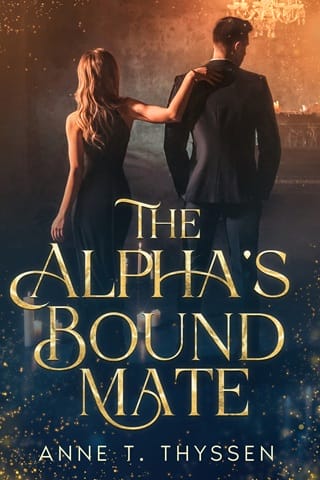2 Queen’s Gate Terrace
2 Queen's Gate Terrace
It was a few minutes after 7:00 a.m. when Sarah Bancroft, still in the clutches of a turbulent dream, stretched a hand toward
the opposite side of the bed and touched only cool Egyptian cotton. And then she recalled the text message that Christopher
had sent her late the previous afternoon, the one about a sudden trip to an undisclosed destination. Sarah had been seated
at her usual table at Wiltons at the time, partaking of a post-work Belvedere martini, three olives, Saharan dry. Depressed
at the prospect of spending yet another evening alone, she had unwisely ordered a second. What followed was for the most part
a blur. She recalled a rainy taxi ride home to Kensington and a search for something wholesome in the Sub-Zero. Finding nothing
of interest, she had settled for a tub of H?agen-Dazs—gelato creamy fudge brownie. Afterward she had fallen into bed in time
for the News at Ten . The lead story concerned the discovery of a body near Land's End in Cornwall, by all appearances the fifth victim of a serial
killer the lesser tabloids had christened the Chopper.
It would have been reasonable for Sarah to blame her unsettled dreams on the second martini or the Cornish axe murderer, but the truth was she had more than sufficient horrors buried in her subconscious to disturb her nights. Besides, she never slept well when Christopher was away. An officer of the Secret Intelligence Service, he traveled often, most recently to Ukraine, where he had spent the better part of the autumn. Sarah did not begrudge his work, for in a previous life she had served as a clandestine operative for the CIA. She now managed a sometimes-solvent Old Master art gallery in St. James's. Her competitors knew nothing of her complicated past and even less about her ruggedly handsome husband, believing him to be a well-to-do business consultant called Peter Marlowe. Thus the handmade suits, the Bentley Continental motorcar, and the maisonette in Queen's Gate Terrace, one of London's poshest addresses.
The windows of their bedroom overlooked the garden and were streaked with rain. Not yet prepared to face the day, Sarah closed
her eyes and dozed until nearly eight, when she finally roused herself from bed. Downstairs in the kitchen she listened to
Today on Radio 4 while waiting for the Krups automatic to complete its labors. It seemed the corpse in Cornwall had acquired an
identity overnight: Dr. Charlotte Blake, a professor of art history from Oxford University. Sarah recognized the name; Professor
Blake was a world-renowned specialist in the field of provenance research. Moreover, a copy of her recent bestselling book
about the turbulent life of Paul Gauguin was at that moment resting on Sarah's bedside table.
The remainder of the morning's news was little better. Taken together, it painted a picture of a nation in terminal decline. A recent study had concluded that the average British subject would soon be less affluent than his counterparts in Poland and Slovenia. And if the British subject were to suffer a stroke or heart attack, he would likely endure a wait of ninety minutes for an ambulance to take him to the nearest A&E ward, where some five hundred people were dying each week due to overcrowded conditions. Even the Royal Mail, one of Britain's most revered institutions, was in danger of collapse.
It was the Conservatives, in power for more than a decade, who had presided over this state of affairs. And now, with the
prime minister foundering, they were bracing for the prospect of a bruising leadership contest. Sarah wondered why any Tory
politician would aspire to the job. Labour held a commanding lead in the polls and were expected to easily prevail in the
next election. Sarah, however, would have no say in the composition of the next British government. She remained a guest in
this country. A guest who moved in elite circles and was married to an SIS officer, she thought, but a guest nonetheless.
There was one piece of good news that morning—from the art world, of all places. Self-Portrait with Bandaged Ear by Vincent van Gogh, stolen from the Courtauld Gallery in a daring smash-and-grab robbery more than a decade ago, had been
recovered under mysterious circumstances in Italy. The painting would be unveiled that evening during an invitation-only event
in the gallery's newly refurbished Great Room. Most of London's art glitterati would be in attendance, as would Sarah. She
had acquired an MA in art history from the Courtauld Institute before collecting a PhD from Harvard, and now served on the
gallery's board of trustees. She also happened to be a close friend and associate of the Venice-based conservator who had
knocked the Van Gogh into shape before its repatriation to Britain. He, too, planned to attend the unveiling—clandestinely,
of course. Otherwise, his very presence might well overshadow the return of the iconic painting.
The ceremony was on the early side—six o'clock, with a cocktail reception to follow—so Sarah dressed in a striking Stella McCartney double-breasted blazer and skirt. The heels of her Prada pumps tapped a metronomic rhythm, forty-five minutes later, as she crossed the paving stones of Mason's Yard, a tranquil quadrangle of commerce concealed behind Duke Street. Isherwood Fine Arts, purveyors of museum-quality Old Master paintings since 1968, stood in the northeast corner of the courtyard, occupying three floors of a sagging Victorian warehouse once owned by Fortnum & Mason. As usual, Sarah was the first to arrive. After disarming the alarm, she unlocked the two doors, one fashioned of stainless-steel bars, the other of shatterproof glass, and went inside.
The gallery's office was located on the second floor. Once there had been a desk for a receptionist—the ravishing but useless
Ella was the last occupant—but Sarah, in a cost-cutting move, had eliminated the position. The telephone, email correspondence,
and appointment book were now her responsibility. She also handled the day-to-day business affairs and had veto authority
over all new acquisitions. Ruthlessly she had shed much of the gallery's dead stock—manner of such-and-such, workshop of so-and-so—at
bargain-basement prices. Even so, Sarah was the curator of one of the largest collections of Old Master paintings in Britain,
enough to fill a small museum, if she were so inclined.
There were no appointments scheduled for that morning, so she tended to an outstanding billing matter, namely, a certain Belgian collector who seemed shocked to learn that he actually had to pay for the French School painting he had acquired from Isherwood Fine Arts. It was one of the oldest tricks in the book, effectively borrowing a painting from a dealer for a few months and then sending it back. Julian Isherwood, the gallery's founder and namesake, seemed to specialize in these types of arrangements. By Sarah's estimate, Isherwood Fine Arts was owed more than a million pounds for works that had already shipped. It was her intention to collect every last penny, beginning with the one hundred thousand pounds owed to the gallery by one Alexis De Groote of Antwerp.
"I would prefer to discuss this matter with Julian," the Belgian sputtered.
"I'm sure you would."
"Have him call me the minute he arrives."
"Yes, of course," said Sarah, and hung up the phone as Julian teetered through the doorway. It was a few minutes after eleven,
considerably earlier than his normal arrival time. These days he typically dropped by the gallery around noon and by one o'clock
was sitting down to lunch at one of London's better tables, usually with female company.
"I assume you heard about poor Charlotte Blake," he said by way of greeting.
"Awful," replied Sarah.
"A terrible way to go, the poor thing. Her death will undoubtedly cast a pall over tonight's proceedings."
"At least until the veil comes off that Van Gogh."
"Is our friend really planning to attend?"
"He and Chiara arrived last night. The Courtauld is putting them up at the Dorchester."
"How are they possibly managing?" Julian removed his mackintosh and hung it on the coat tree. He wore a chalk stripe suit
and a lavender necktie. His plentiful gray locks were in need of a pruning. "What in heaven's name is that awful sound?"
"Could be the telephone."
"Shall I answer it?"
"Do you remember how?"
Frowning, he snatched up the receiver and raised it resolutely to his ear. "Isherwood Fine Arts. Isherwood himself speaking... As a matter of fact, she is. One moment, please." He managed to place the call on hold without disconnecting it. "It's Amelia March from ARTnews . She'd like a word."
"About what?"
"Didn't say."
Sarah picked up the phone. "Amelia, darling. How can I be of help?"
"I'd love a comment from you for a rather intriguing story I'm working on."
"The Charlotte Blake murder?"
"Actually, it concerns the identity of the mysterious art restorer who cleaned the Van Gogh for the Courtauld. You'll never
guess who he is."
 Fullepub
Fullepub 



